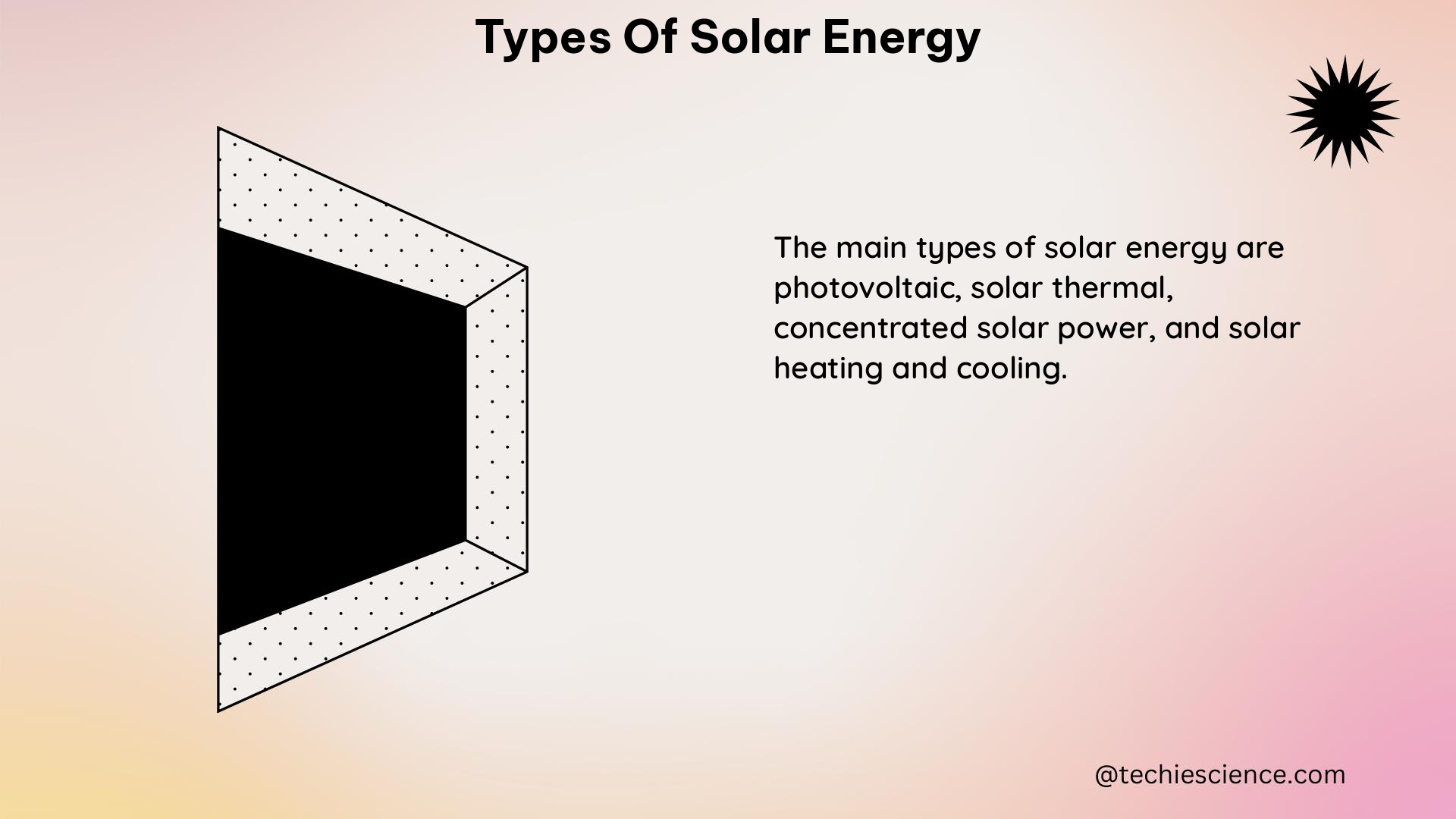Solar energy is a rapidly growing and increasingly important source of renewable energy, with two primary technologies leading the way: Photovoltaic (PV) systems and Concentrating Solar Power (CSP) systems. This comprehensive guide delves into the technical details, physics principles, and practical applications of these two solar energy technologies, providing a valuable resource for physics students and enthusiasts alike.
Photovoltaic (PV) Systems
Photovoltaic (PV) systems are the most widely deployed solar energy technology, converting sunlight directly into electricity using semiconductor materials, such as silicon. The underlying physics behind PV systems is the photovoltaic effect, where the absorption of photons in the semiconductor material generates electron-hole pairs, which are then separated and collected to produce an electric current.
Photovoltaic Effect
The photovoltaic effect is the fundamental principle that drives PV systems. When photons from sunlight are absorbed by the semiconductor material in a PV cell, they excite electrons in the material, causing them to break free from their atoms and creating electron-hole pairs. These charge carriers are then separated by the built-in electric field in the PV cell, generating a flow of electric current.
The efficiency of the photovoltaic effect is determined by the bandgap energy of the semiconductor material, which represents the energy required to excite an electron from the valence band to the conduction band. The bandgap energy of silicon, the most commonly used semiconductor in PV cells, is 1.12 eV, which corresponds to a wavelength of approximately 1100 nm in the near-infrared region of the electromagnetic spectrum.
PV Cell Design and Efficiency
PV cells are typically made of thin wafers of semiconductor materials, with the most common being crystalline silicon (c-Si) and thin-film technologies, such as amorphous silicon (a-Si), cadmium telluride (CdTe), and copper indium gallium selenide (CIGS). The design of PV cells aims to maximize the collection and separation of the electron-hole pairs generated by the photovoltaic effect, as well as to minimize energy losses due to recombination and resistance.
The efficiency of PV cells in converting sunlight into electricity varies, with typical commercial modules having efficiencies ranging from 15% to 22%. The efficiency of PV systems is influenced by factors such as the semiconductor material, cell design, module configuration, and environmental conditions, such as temperature and irradiance.
PV System Components and Configuration
A complete PV system consists of several key components, including:
- PV modules: These are the primary energy-generating units, made up of interconnected PV cells.
- Inverters: These devices convert the direct current (DC) generated by the PV modules into alternating current (AC) that can be used by the electrical grid or local loads.
- Mounting structures: These support the PV modules and orient them towards the sun to maximize energy production.
- Balance of system (BOS) components: These include wiring, combiner boxes, disconnects, and other electrical components necessary for the proper functioning of the PV system.
PV systems can be configured in various ways, such as grid-connected systems, off-grid systems, and hybrid systems that combine PV with other energy sources, such as batteries or diesel generators.
PV System Performance and Capacity Value
The performance of PV systems is typically measured in terms of their capacity value, which represents the level of reliability they can provide to the electrical grid. The capacity value of PV plants can range from 50% to 80% of their AC rating, with the higher values representing systems that use active tracking to orient the PV modules towards the sun.
Active tracking systems, which use motors to continuously adjust the orientation of the PV modules, can significantly improve the energy output and capacity value of PV systems. However, these systems also come with additional complexity, maintenance requirements, and energy consumption, which must be weighed against the potential benefits.
Concentrating Solar Power (CSP) Systems

Concentrating Solar Power (CSP) systems, also known as solar thermal power plants, use mirrors or lenses to concentrate a large area of sunlight onto a small area, generating heat that is then converted into electricity. This approach differs from PV systems, which directly convert sunlight into electricity.
CSP System Components and Technologies
CSP systems typically consist of the following key components:
- Solar collectors: These are the mirrors or lenses that concentrate the sunlight onto a receiver.
- Receivers: These absorb the concentrated solar radiation and convert it into thermal energy.
- Heat transfer fluid: This fluid, such as molten salt or synthetic oil, carries the thermal energy from the receiver to the power block.
- Power block: This is where the thermal energy is converted into electricity, typically using a steam turbine or Stirling engine.
- Thermal energy storage: Some CSP systems include thermal energy storage, allowing them to generate electricity even when the sun is not shining.
There are several different CSP technologies, including:
- Parabolic trough: Curved, trough-shaped mirrors focus sunlight onto a receiver tube running along the focal line of the trough.
- Solar power tower: A field of mirrors (heliostats) focuses sunlight onto a receiver at the top of a central tower.
- Parabolic dish: Dish-shaped mirrors concentrate sunlight onto a receiver located at the focal point of the dish.
- Linear Fresnel reflector: Flat or slightly curved mirrors focus sunlight onto a linear receiver.
CSP System Efficiency and Capacity Value
The efficiency of CSP systems in converting solar energy into electricity varies, depending on the specific technology and design. Typical commercial CSP plants have efficiencies in the range of 15% to 25%.
The capacity value of CSP plants without storage can be similar to that of PV plants, meaning that a 100-MW (AC rated) CSP plant can potentially provide the same level of reliability as a 50-MW to 80-MW conventional plant, depending on the type and location of the CSP system.
However, CSP systems with thermal energy storage can have significantly higher capacity values, as they can generate electricity even when the sun is not shining. This storage capability allows CSP plants to provide a more reliable and dispatchable source of electricity, making them an attractive option for grid integration.
Land Use and Environmental Impacts
The land use and environmental impacts of solar energy systems, including both PV and CSP, are important considerations. A study on standardized metrics to quantify solar energy-land relationships found that the land-use intensity of electricity production varies widely across different solar energy technologies and land-use contexts.
For example, the land-use intensity of utility-scale PV systems can range from 0.3 to 2.8 acres per megawatt-hour (MWh) of annual electricity generation, while the land-use intensity of CSP systems can range from 1.4 to 4.5 acres per MWh. These variations are influenced by factors such as the specific technology, solar resource quality, and local land-use characteristics.
It is important to consider the full life cycle of solar energy systems, including the production, installation, operation, and decommissioning phases, when evaluating their land-use impacts. A systematic literature review identified 80 articles that addressed land-related properties of PV and CSP solar energy generation technologies, underscoring the importance of this topic.
Conclusion
Photovoltaic (PV) and Concentrating Solar Power (CSP) systems are the two primary types of solar energy technologies, each with its own unique characteristics and applications. PV systems directly convert sunlight into electricity using semiconductor materials, while CSP systems use mirrors or lenses to concentrate sunlight and generate heat that is then converted into electricity.
Both PV and CSP systems have their own advantages and challenges, and the choice between them depends on factors such as the available solar resource, land use constraints, and the specific energy needs of the application. As the solar energy industry continues to evolve, a deeper understanding of the technical details, physics principles, and practical considerations of these technologies will be crucial for advancing the field and meeting the growing demand for renewable energy.
References:
- National Renewable Energy Laboratory. “Best Practices Handbook for the Collection and Use of Solar Energy Systems Data.” NREL, 2018.
- Frontiers in Sustainability. “Standardized metrics to quantify solar energy-land relationships.” Frontiers, 2022.
- Office of Energy Efficiency and Renewable Energy. “Solar Energy and Capacity Value.” NREL, 2013.
- Sun Yanwei, Li Ying Wang, Run Ma, and Renfeng. “Measuring dynamics of solar energy resource quality: Methodology and policy implications for reducing regional energy inequality.” ScienceDirect, 2022.











